A) total revenue is at a maximum.
B) marginal cost equals marginal revenue.
C) average variable cost equals marginal cost.
D) total cost is at a minimum.
Correct Answer

verified
Correct Answer
verified
Multiple Choice
The difference between the maximum price a consumer is willing to pay for a product and the actual price the consumer pays is:
A) allocative efficiency.
B) productive efficiency.
C) consumer surplus.
D) producer surplus.
Correct Answer

verified
Correct Answer
verified
Multiple Choice
A firm sells a product in a purely competitive market.The marginal cost of the product at the current output of 1000 units is $2.50.The minimum possible average variable cost is $2.00.The market price of the product is $2.50.To maximize profit or minimize losses,the firm should:
A) continue producing 1000 units.
B) produce less than 1000 units.
C) produce more than 1000 units.
D) shut down.
Correct Answer

verified
Correct Answer
verified
Multiple Choice
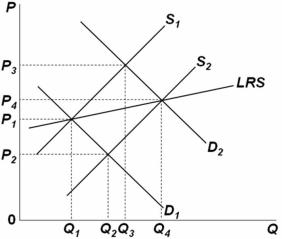 The industry represented by the graph above where S1 and S2 are short-run supply curves,D1 and D2 are short-run demand curves,and LRS is the long-run supply curve can be said to be:
The industry represented by the graph above where S1 and S2 are short-run supply curves,D1 and D2 are short-run demand curves,and LRS is the long-run supply curve can be said to be:
A) a constant-cost industry.
B) an average-cost industry.
C) a decreasing-cost industry.
D) an increasing-cost industry.
Correct Answer

verified
Correct Answer
verified
Multiple Choice
In general,in the short run,the supply curve of a purely competitive firm is:
A) identical to the marginal-cost curve.
B) a horizontal line equal to the market price.
C) the rising portion of the average-total-cost (ATC) curve.
D) the rising portion of the marginal-cost curve above the AVC curve.
Correct Answer

verified
Correct Answer
verified
Multiple Choice
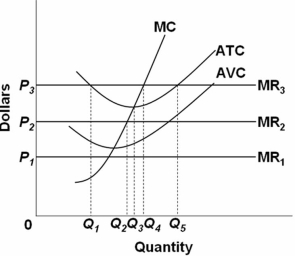 Refer to the above diagram.All data are for the short run.If product price is P3,the firm will:
Refer to the above diagram.All data are for the short run.If product price is P3,the firm will:
A) produce Q4 units and break even.
B) produce Q4 units and make an economic profit.
C) produce Q5 units and break even.
D) shut down.
Correct Answer

verified
Correct Answer
verified
Multiple Choice
The table below shows cost data for a firm that is selling in a purely competitive market. 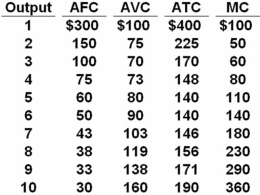 Refer to the above table.If the market price for the firm's product is $70,the competitive firm will:
Refer to the above table.If the market price for the firm's product is $70,the competitive firm will:
A) produce one unit.
B) produce two units.
C) produce three units.
D) shut down.
Correct Answer

verified
Correct Answer
verified
Multiple Choice
A firm should increase the quantity of output as long as its:
A) marginal revenue is greater than its marginal cost.
B) marginal cost is greater than its marginal revenue.
C) average revenue is greater than its average total cost.
D) average revenue is greater than its average variable cost.
Correct Answer

verified
Correct Answer
verified
Multiple Choice
The table below shows cost data for a firm that is selling in a purely competitive market.  Refer to the above cost chart.If the marginal revenue is $6,what output should the firm produce?
Refer to the above cost chart.If the marginal revenue is $6,what output should the firm produce?
A) 10
B) 12
C) 14
D) 20
Correct Answer

verified
Correct Answer
verified
Multiple Choice
If the demand curve facing a firm is perfectly elastic,then:
A) its marginal revenue will equal price.
B) its marginal revenue schedule will decrease at an increasing rate.
C) its marginal revenue schedule decreases twice as fast as the demand curve.
D) it can increase its total revenue by lowering the price of its product.
Correct Answer

verified
Correct Answer
verified
Multiple Choice
Which market model has the least number of firms?
A) Monopolistic competition
B) Pure competition
C) Pure monopoly
D) Oligopoly
Correct Answer

verified
Correct Answer
verified
True/False
Along the purely competitive firm's demand curve,average revenue is equal to marginal revenue.
Correct Answer

verified
Correct Answer
verified
Multiple Choice
In a typical graph for a purely competitive firm,the intersection of the total cost and total revenue curves would be:
A) a point of maximum economic profit.
B) a point of minimum economic loss.
C) a point where MR = MC.
D) a break-even point.
Correct Answer

verified
Correct Answer
verified
Multiple Choice
Which is true for a purely competitive firm in short-run equilibrium?
A) The firm is making only normal profits.
B) The firm's marginal cost is greater than its marginal revenue.
C) The firm's marginal revenue is equal to its marginal cost.
D) A decrease in output would lead to a rise in profits.
Correct Answer

verified
Correct Answer
verified
Multiple Choice
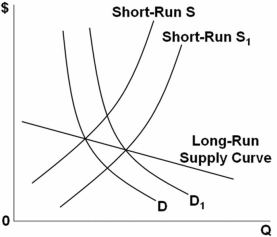 The graph above represents a(n) :
The graph above represents a(n) :
A) decreasing-cost industry: firms may be paying lower prices for their inputs when the industry expands.
B) increasing-cost industry: firms may be paying higher prices for their inputs when the industry expands.
C) competitive,break-even industry: the long-run supply curve is upward sloping as it must be according to the law of supply.
D) constant-cost industry: prices of the inputs stay the same,and other production costs are constant as the industry expands.
Correct Answer

verified
Correct Answer
verified
Multiple Choice
A purely competitive firm is in short-run equilibrium and its MC exceeds its ATC.It can be concluded that:
A) firms will leave the industry in the long run.
B) the firm is realizing an economic profit.
C) the firm is realizing a loss.
D) this is an increasing-cost industry.
Correct Answer

verified
Correct Answer
verified
Multiple Choice
If there is allocative efficiency in a purely competitive market for a product,the minimum price producers are willing to accept is:
A) less than marginal benefit.
B) greater than marginal cost.
C) equal to the amount of efficiency or deadweight losses.
D) equal to the maximum price consumers are willing to pay.
Correct Answer

verified
Correct Answer
verified
Multiple Choice
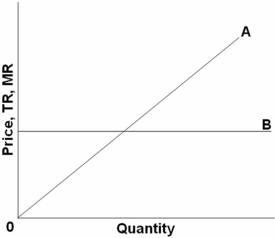 Refer to the above graph for a firm in pure competition.Line B is horizontal because:
Refer to the above graph for a firm in pure competition.Line B is horizontal because:
A) total revenue is greater than marginal revenue.
B) marginal revenue is greater than total revenue.
C) the firm has a perfectly inelastic demand curve.
D) the firm has a perfectly elastic demand curve.
Correct Answer

verified
Correct Answer
verified
True/False
Competitive firms are price takers largely because of intensive advertising by their competitors.
Correct Answer

verified
Correct Answer
verified
Multiple Choice
A firm sells a product in a purely competitive market.The marginal cost of the product at the current output is $5.00 and the market price is $5.00.What should the firm do?
A) Shut down if the minimum possible average variable cost is $5.25.
B) Shut down if the minimum possible average variable cost is $4.75.
C) Increase output if the minimum possible average variable cost is $5.25.
D) Decrease output if the minimum possible average variable cost is $4.75.
Correct Answer

verified
Correct Answer
verified
Showing 21 - 40 of 155
Related Exams